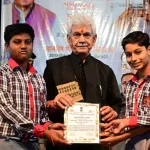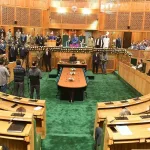NATIONAL NUTRITION MONTH
Nutritional security continues to be a major health concern in the country. According to World Health Organization (WHO), India contributes a third of the global burden of under nutrition. The country ranked 107 out of 121 countries based on the Global Hunger Index (GHI) 2022. The GHI 2022 report that aims to comprehensively measure and track hunger at the global, regional and country levels arrives at the hunger index on the basis of four indicators viz undernourishment referring to the share of the population with insufficient caloric intake; Child Wasting i. e share of children under age five who have low weight for their height reflecting acute under-nutrition; Child Stunting depicting the share of children under age five who have low height for their age reflecting chronic under-nutrition and finally child mortality describing the mortality rate of children under the age of five.
Based on the values of the four indicators, the GHI determines hunger on a 100-point scale where 0 is the best possible score (no hunger) and 100 is the worst. Each country’s GHI score is classified by severity, from low to extremely alarming. Undernourishment data are provided by the Food and Agriculture Organization and Child Mortality data are sourced from the UN Inter-agency Group for Child Mortality Estimation (UN IGME).Child wasting and stunting data are drawn from the joint database of UNICEF, the World Health Organization (WHO) and the World Bank among others.
On the severity scale, the countries with a score of less than or equal to 9.9 are in low level of hunger category, those with score in between 10 to 19.9 fall under moderate category of hunger and those with a score of 20-34.9 are categorized as countries with serious levels of hunger. India with a score of 29.1 has a level of hunger that is serious. With the 2022 report, India has slipped 6 positions from its 2021 rank of 101 making it the country having the highest child wasting rate among children. What is worse is that India is ranked behind most of its neighboring countries. Pakistan is at 99th spot, Sri Lanka at 64th, Nepal at 81st and Bangladesh at 84th in the GHI 2002. The only country in South Asia that performs worse than India on the index is Afghanistan with 109th rank.
Although, India has seen improvement in child stunting and child mortality between 2014 and 2022, but undernourishment has increased. The report claims that child stunting has declined from 38.7% to 35.5%.Child mortality has also dropped from 4.6% to 3.3%. On the other hand, prevalence of undernourishment has also risen in the country from 14.6% in 2018-2020 to 16.3% in 2019-2021. It implies that 224.3 million people in India (out of 828 million globally) are considered under-nourished. India’s child wasting rate (low weight for height) at 19.3% is worse than the levels recorded in 2014 (15.1%) and even 2000 (17.15%).Although the country has made huge progress in food grain production and reduction in poverty and hunger; yet the situation at the ground level has not changed so much. The country still witnesses a high prevalence of low birth weight, high morbidity and mortality in children and poor maternal nutrition of the mother.
This continues to be major nutritional concern in India. The major nutritional problems are protein energy malnutrition (PEM), vitamin A deficiency (VAD), iron deficiency anemia (IDA) and iodine deficiency disorders (IDD). The different nationwide nutritional interventions have not been able to make much headway in dealing with nutritional problems. The findings of National Health Policy 2017 presented by the Ministry of Health and Family Welfare, Govt. of India highlighted the negative impact of malnutrition on the population’s productivity, and its contribution to mortality rates in the country.
Malnutrition indicates that children are either too short for their age or too thin. Children whose height is below the average for their age are considered to be stunted. Similarly, children whose weight is below the average for their age are considered thin for their height or wasted. Together, the stunted and wasted children are considered to be underweight indicating a lack of proper nutritional intake and inadequate care post childbirth. India’s performance on key malnutrition indicators is poor according to national and international studies. The prevalence of underweight children has been found to be higher in rural areas than urban areas. According to WHO, infants weighing less than 2.5 Kg are 20 times more likely to die than heavier one.
In India, the national average weight at birth is less than 2.5 Kg for 19% of the children. The incidence of low birth-weight babies varied across different states, with Madhya Pradesh, Rajasthan and Uttar Pradesh witnessing the highest number of underweight childbirths at 23%. Further, more than half of India’s children are anemic (58%), indicating an inadequate amount of hemoglobin in the blood. This is caused by a nutritional deficiency of iron and other essential minerals, and vitamins in the body. Malnutrition is not only confined to children. Among adults, 23% of women and 20% of men are considered undernourished in India. On the other hand, 21% of women and 19% of men are overweight or obese. The simultaneous occurrence of over nutrition and under-nutrition indicates that adults in India are suffering from a dual burden of malnutrition (abnormal thinness and obesity).
National Nutrition Month/Rashtriya Poshan Mah: To ensure nutritional security of all by creating awareness and sensitization about the role and importance of a healthy diet, the government of India has launched various initiatives to improve the nutritional status in the country. The month of September every year is celebrated as the Rashtriya Poshan Maah or the National Nutrition Month across the country. Various awareness and sensitization activities are being conducted all across the country which focuses on key themes like balanced diet, women health, children education, reproductive and child health care, health of adolescent girls, importance of traditional food especially in tribal areas. Many other programmes like the Integrated Child Development Services (ICDS), the National Rural Health Mission (NRHM), the National Health Mission (NHM), Janani Suraksha Yojana, the Mid-Day Meal (MDM) Scheme, the National Food Security Mission (NFSM) and many other schemes also work towards nutritional security.
The Ministry of Health and Family welfare has also released the National Nutrition Strategy. The Strategy aims to reduce all forms of malnutrition by 2030, with a focus on the most vulnerable and critical age groups. The Strategy also aims to assist in achieving the targets identified as part of the Sustainable Development Goals related to nutrition and health. The strategy has interventions with a focus on improving healthcare and nutrition among children. These interventions include: (i) promotion of breastfeeding for the first six months after birth, (ii) universal access to infant and young child care (including ICDS and crèches), (iii) enhanced care, referrals and management of severely undernourished and sick children, (iv) bi-annual vitamin A supplements for children in the age group of 9 months to 5 years, and (v) micro-nutrient supplements and bi-annual de-worming for children. In this strategy measures to improve maternal care and nutrition include: (i) supplementary nutritional support during pregnancy and lactation, (ii) health and nutrition counseling, (iii) adequate consumption of iodized salt and screening of severe anemia (iv) institutional child birth, lactation management and improved post-natal care.
It would not be wrong to say that the nutritional security is under assault on multiple fronts. Worsening conflict, weather extremes associated with global climate change, and the economic and health challenges associated post Covid-19 pandemic are all driving hunger and malnutrition. Let all of us contribute in whatever way we can to ensure that each one of us gets adequate nutrients required for our growth and well being.
(The author is Scientist at SKUAST-K; can be reached at: [email protected])





